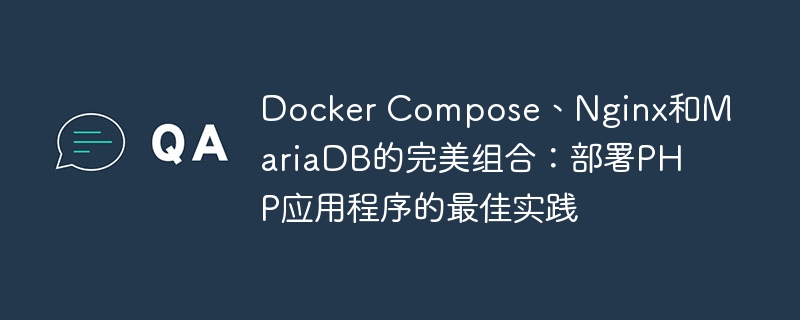

The perfect combination of Docker Compose, Nginx and MariaDB: Best practices for deploying PHP applications
Introduction:
In modern web application development, use Containerization technology has become a trend. Containerization technology can package an application and its dependencies into a single container, so that the application can run in any environment that supports containerization technology. Docker is currently the most popular containerization technology, which can simplify the deployment, management and expansion of applications.
For web applications developed using PHP, we can use Docker Compose to manage multiple containers, including Nginx, PHP, and databases. This article will introduce how to use Docker Compose, Nginx and MariaDB to deploy and manage a PHP application, and provide specific code examples.
Install Docker and Docker Compose
First, we need to install Docker and Docker Compose on the host. You can visit the Docker official website (https://www.docker.com/) to download and install. After the installation is complete, we can confirm whether Docker is installed correctly by running the following command:
docker --version docker-compose --version
Create a Docker Compose file
Create a file named docker-compose in the root directory of the project .yml file used to define the application's services and corresponding configuration. The following is an example of a simple docker-compose.yml file:
version: '3' services: web: build: context: . dockerfile: Dockerfile ports: - 80:80 volumes: - ./src:/var/www/html depends_on: - db db: image: mariadb environment: MYSQL_ROOT_PASSWORD: 123456 MYSQL_DATABASE: mydb MYSQL_USER: user MYSQL_PASSWORD: password volumes: - db-data:/var/lib/mysql volumes: db-data:
The above docker-compose.yml file defines two services, one is a web service for running Nginx and PHP, and the other is a db Service for running MariaDB. The web service exposes port 80 to the external host and maps the src folder in the project directory to the /var/www/html directory in the container. The db service sets MariaDB's environment variables and data volumes for persistent storage of database data.
Create Dockerfile
In order to build the custom image required for the web service, we need to create a file named Dockerfile in the project directory. The following is an example of a simple Dockerfile:
FROM php:7.4-fpm RUN docker-php-ext-install pdo_mysql WORKDIR /var/www/html
The above Dockerfile is based on the official php:7.4-fpm image, has the pdo_mysql extension installed, and sets the working directory to /var/www/html.
Start the container
Execute the following command in the root directory of the project to start the container:
docker-compose up -d
By running the above command, Docker will follow the docker-compose.yml file The configuration in starts the web and db services. The -d parameter indicates running the container in background mode.
Configuring Nginx
In order for Nginx to correctly forward requests to the PHP application in the web service, we need to add the following configuration items to the Nginx configuration:
server {
listen 80;
server_name localhost;
root /var/www/html;
index index.php index.html;
location / {
try_files $uri $uri/ /index.php?$query_string;
}
location ~ .php$ {
fastcgi_pass web:9000;
fastcgi_param SCRIPT_FILENAME $document_root$fastcgi_script_name;
include fastcgi_params;
}
}The above configuration file forwards the request to the PHP-FPM process running in the web service and passes PHP-related environment variables to PHP-FPM.
Write PHP application
Write PHP application code in the src folder under the project directory. Here we take a simple Hello World program as an example:
<?php echo "Hello World!";
Summary:
By using a combination of Docker Compose, Nginx and MariaDB, we can easily deploy and manage PHP applications. Docker Compose provides a simple and powerful way to define and run multiple containers, Nginx as a web server can handle a large number of concurrent requests, and MariaDB provides a stable and reliable database service. We hope that through the introduction and examples in this article, readers can better understand and apply these technologies and benefit from them in actual projects.
The above is the detailed content of The perfect combination of Docker Compose, Nginx and MariaDB: best practices for deploying PHP applications. For more information, please follow other related articles on the PHP Chinese website!
 The difference between k8s and docker
The difference between k8s and docker
 nginx restart
nginx restart
 Detailed explanation of nginx configuration
Detailed explanation of nginx configuration
 Detailed explanation of nginx configuration
Detailed explanation of nginx configuration
 What are the differences between tomcat and nginx
What are the differences between tomcat and nginx
 What are the methods for docker to enter the container?
What are the methods for docker to enter the container?
 What should I do if the docker container cannot access the external network?
What should I do if the docker container cannot access the external network?
 What is the use of docker image?
What is the use of docker image?




